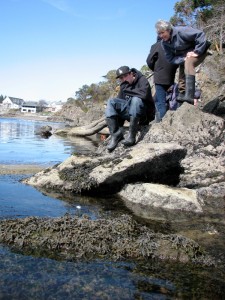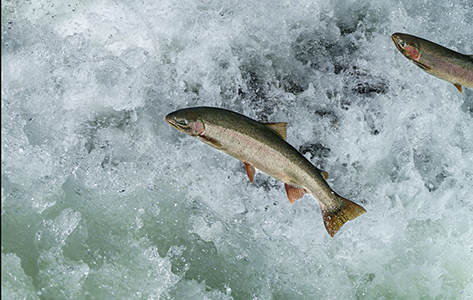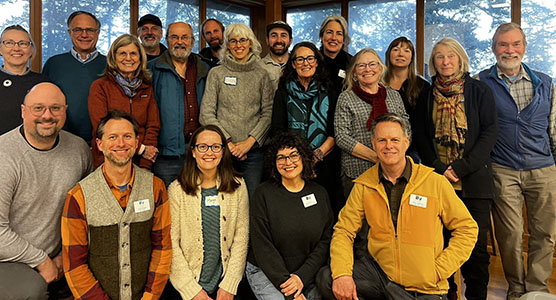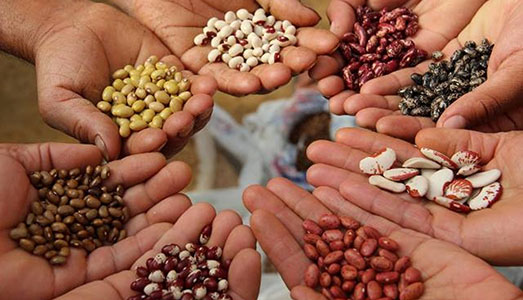Updated April 17 at 9:30 a.m.
Juvenile herring may be detected soon, following spawn event
Why were the waters of East Sound a tropical blue near Madrona Point late last month?
Thanks to the “footwork” of Marta Branch’s marine science and marine biology classes, there appears to be an eventful answer — the herring are back!
When she was alerted to the change in East Sound waters (see accompanying photo below) Marta Branch collected plankton on Monday, March 28, from the Madrona dock.
In class the next day, students brainstormed the possible “Abiotic, Biotic and Anthropogenic” [unliving, living, and man-made] causes of the water color and cloudiness and discussed and presented their hypotheses. The class then went to the pocket beach next to the county dock to investigate. “We picked up eggs cemented to various types of macroalgae that look an awful lot like herring eggs,” says Branch.
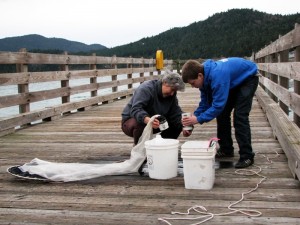
Marta Branch and Chase Drake examine the plankton tow net, in search of an explanation for the cloudy East Sound waters.
Following is a report by the Orcas Island High School Marine Technology Students on their research and findings:
The Orcas Island High School Marine Technology class researched the discolored water in East Sound.
[On March 28] the water in East Sound resembled the color of a nice day in the Bahamas instead of the usual dark green gray. It appeared to be an aqua/turquoise color which made us question what was going on with our water?
On the 29th of March, the following day, the water appeared to be the same with absolutely no change. We couldn’t figure out why the water was a different color so [we] decided to begin an investigation of the waters of East Sound.
Both [marine science and marine technology] classes continued to research and discuss the cause of this color change, and brain-stormed their thoughts:
- One thought was possibly it could be an effect from the tsunami in Japan and that we gotten particles and water from that side of the world;
- Another thought was it could possibly be some sort of chemical spill out at sea that could be causing the light color to our waters;
- Another theory about this change was that it could possibly be spawning season for Pacific herring.
So the Marine Technology class thought they could prove that it could be spawning season. It would be hard to prove that there was a chemical spill at sea, or that all of this could be because of the tsunami in Japan.
The Marine Technology class [then] walked down to Madrona Point Public Pier, where East Sound water was a changed color, from a point near the northeast reach of the Fishing Bay side of Madrona Point to a point where we took samples from Madrona Point dock about ten feet out into the water. We took a bucket sample, which involves dropping a bucket into the water and putting water into it.
Also we took samples of the murky water, herring eggs, and leftover foam from various points around the pier at Madrona Point and all the way north to the beach in front of Madrona Bar and Grill.
The following Tuesday (April 5) students from the Marine Science class spent an hour debating what might have caused the color change in the water. One theory that was “floated” was that there might have been a spawing event and the fish milt turned the water milky, which then reflected the blue light from the sky.
Students reasoned that if fish were spawning, then eggs might be present. Sinceherring lay their eggs on seaweed and eelgrass, maybe some of the eggs would wash up on shore.
Students went down to the pocket beach at Madrona Point pier and looked in the wrack line for Herring eggs that might have washed up. They were successful and brought some back to the classroom as samples.
On Thursday, April 7, students from the afternoon Marine Technology course met a diver (Marta Branch’s son Kellan Bernhardt) down on the dock at Madrona Point. There was a low tide at 2 p.m. and students were hoping to find herring eggs present in the vegetation that was exposed by the low tide and to map the extent of the area with eggs.
They wanted the diver to confirm that the eggs were attached to seaweed down deep in the water where they might hatch in 2-3 weeks. Eggs were found by the students all around the pocket beach and north in the water, attached to Fucus seaweed and other seaweeds. Eggs were found from about +.4 feet (0.4 feet above sealevel) to a depth of about 12 feet below sea level.
Some eggs were collected by our diver and taken back to Friday Harbor Labs by our Graduate K-12 fellow scientist Sylvia Yang to see if they were viable. She will try to hatch them there.
After taking many samples and combing the beach for evidence to solve this mystery, Marta Branch’s two Marine classes have come to the conclusion that the change in water color in East Sound can be attributed to a massive spawning event. The fish doing the spawning in question are Pacific herring. We found many tiny little eggs resembling herring eggs, attached to stationary seaweed in a manner that only Pacific herring lay their eggs.
So now you can sleep knowing that this wasn’t some massive leak of dye into the Sound, or some radiation from the Fukushima Daiichi power plant, or even some of the wilder hypotheses like a massive dump of some kind of white powder by smugglers.
Marta Branch said, ”The marine science kids and the marine technology kids continue to work on this question, and to collect various samples and clues to help this along. “
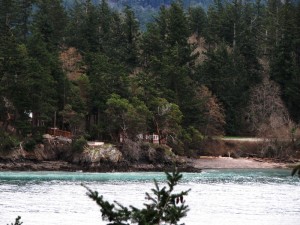
Cloudy aqua-colored waters near the shore of Madrona Point indicate herring spawn spawn. Photo (enhanced) courtesy of Marta Branch.
Russel Barsh, founder and head of Kwiáht, the Center for the Historical Ecology of the Salish Sea, said on April 4, after examining the research samples, “OK, gang, it really looks like it was herring. We still don’t know whether any of the eggs will survive to hatch and produce juvenile herring in Fishing Bay. There was little living eelgrass or kelp where the spawning occurred. A lot of the eggs ended up on floating detrital kelp that may wash up on a beach where the eggs will bleach, dry out, and die.
“But if some eggs stay in Fishing Bay and hatch, we should see them when we go seining. Incubation time for herring eggs is 14-21 days, and we are scheduled to go fishing again on April 21 and May 7. If we set at least once on the east side of Indian Island, we maximize our likelihood of encountering little herring.
Barsh continued, “There used to be a lot of herring spawning bays in the islands, but gradually all of them were fished out or modified. Some of us have suspected that there are still some very small undocumented spawning events around the islands each year. And this was just the kind of thing we had in mind — although in truth, I am astonished that it was so close to Eastsound!”
“This is very exciting — a whole new dimension to our program of work! The sea is full of surprises…”
**If you are reading theOrcasonian for free, thank your fellow islanders. If you would like to support theOrcasonian CLICK HERE to set your modestly-priced, voluntary subscription. Otherwise, no worries; we’re happy to share with you.**

